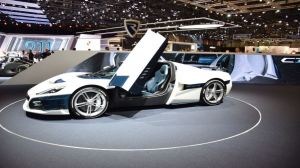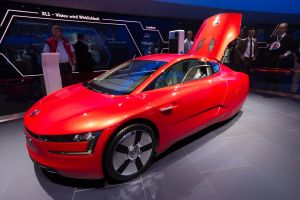Geneva Motor Show 2020 Preview
This year on the 3rd of March the 90th Geneva International Motor Show will take its place. Over 90 world or European premieres confirmed to be presented on the show with over 150 exhibitors, including everyone’s favorite performance and luxury marques as well as many newcomers.
Approximately 700,000 visitors are expected to cross the floors of the various halls that make up Geneva’s Palexpo convention center. The Motor Authority team will also be covering the show to bring you the latest information and live photos.
Top players will be presented including the following models:
2021 Audi A3: A more high-tech, more dynamic Audi A3 is coming for the 2021 model year and we'll see it for the first time in Geneva. The version to be shown will be the Sportback but the debut of the sedan is likely not far off. The new A3 is more of a heavy update of the current model than a true redesign but there will still be plenty of new tech, including new systems for the all-wheel drive, suspension damping, and speed-sensitive steering.
2021 Aston Martin Vantage: Aston Martin will have an updated Vantage on display. Key among the updates is the new Vantage Roadster body style which looks particularly fetching with the new, more traditional front fascia design that's also being made available for the latest model year. Peak output remains unchanged at 503 horsepower and right now only the coupe is available with a manual transmission, with the Vantage Roadster coming standard with an 8-speed automatic.
Hispano-Suiza Carmen Boulogne: Spain's Hispano-Suiza will show us a new performance variant of its 1,000-plus-hp Carmen electric grand tourer. The Boulogne was developed by Hispano-Suiza's Tailormade personalization department and is said to reference Hispano-Suiza’s racing vehicles from the 1920s, while still retaining the grand touring qualities, including luxury, of the Carmen
Polestar Precept: Polestar will unveil a concept of a large fastback sedan. We mean seriously large, as the wheelbase is six inches longer than the one on the Tesla Model S. The concept hasn't been confirmed for production but we know its design and technology will end up in future models from the Swedish performance EV brand.
2021 Mercedes-Benz E-Class: Mercedes-Benz's popular mid-size sedan, the E-Class, is about to undergo a mid-cycle update and we'll get our first look at the refreshed model in Geneva. There will be revised styling, but of more more significance will be tech updates made to the car. Key among these will be Mercedes' MBUX infotainment system which features a large touchscreen (10.25 inches as standard on the updated E-Class) that can be operated much like a smartphone or tablet.
Source: Motor Authority, 2020
The Company has started building its first mass-market EV, the ID3, in Germany. The compact hatchback will be a rival to Tesla's Model 3, which has helped lift the U.S. automaker's sales in Europe.
While Tesla is paving the way in electric cars, VW is buying software companies and ramping up investments in sustainable vehicles and battery cells, Diess said Friday at the World Economic Forum in Davos, Switzerland.
"It's an open race," Diess said in an interview with Bloomberg TV. "We are quite optimistic that we still can keep the pace with Tesla and also at some stage probably overtake," he said.
Tesla's market value surpassed VW's for the first time this week, even as the U.S. company sells a fraction of the cars VW produces and has yet to record an annual profit.
Still, Tesla has a competitive edge in electric cars and software, technologies that are underpinning a shift toward cleaner mobility.
The threat is underscored by Musk's plan to establish a factory near Berlin, in the heart of Germany's automotive industry.
Diess last week called on his top managers to speed up overhaul efforts to make the company more agile or risk being pushed aside.
"The company which adopts fastest and is most innovative but also which has enough scale in the new world will make the race," Diess said on Friday.
Volkswagen has started building its first mass-market EV, the ID3, in Germany. The compact hatchback will be a rival to Tesla's Model 3, which has helped lift the U.S. automaker's sales in Europe.
U.S. tariffs
Tesla is not Diess's only concern. The CEO was among executives who attended a dinner with U.S. president Donald Trump in Davos on Tuesday. While the meeting was "positive," the threat of U.S. tariffs on European automakers has not been averted, Diess said.
"It's very difficult to read President Trump but he stated that he's still not happy with Europe," Diess said. "We're doing what we can to avoid tariffs."
Volkswagen has been relatively resilient so far to industry headwinds exacerbated by trade friction, higher tariffs and a slowdown in China, the German automaker's largest market. But, the company will have to comply with Europe's new fleet emission targets, Diess said, meaning VW will have to sell more sustainable cars or face penalties.
"2020 for the auto industry will be a very difficult year, " Diess said. "But we're doing the right things to be competitive."
Source: Automotive News, 2020
Sweden – sustainable living as the way of life
The core principle of sustainable development is that members of one generation should act to conserve resources for future generations. For most Swedes today, sustainability is a way of life. Here’s your guide to sustainable living in Sweden.
Living for the future
Sweden ranks first in the EU in consumption of organic foods, leads the way in recycling drinks cans and bottles, and gets the highest share of its energy from renewable sources. What’s more, Swedish fashion retailer H&M is a world leader in using organic cotton and the Government has allocated SEK 400 million for research and development of environment technology.
Green Swedes
In Europe, where the organic food market is growing by 5-7 per cent a year, Sweden ranks at the top of the green shoppers list. A study by the European Commission found that 40 per cent of Swedes had purchased an eco-labeled item in the past month, which is more often than the European average.
In recent years, more stores with organic apparel have opened while established brands have started to use organic fabrics in their collections. According to the organization Textile Exchange, H&M is the world’s largest user of organic cotton.
Vintage fashion
The secondhand clothing market, both in stores and online, is also growing. Vintage fashion is so popular that even established chains are selling second-hand items. Swedish clothing company Weekday sells vintage pieces alongside new apparel, as does fashion store Grandpa. Sweden’s first and only vintage clothing fair, Vintagemässan, started in Stockholm in 2008, and now attracts more than 6,000 people every year.
Recycling leader
Swedes were more conscientious about recycling beverage containers in 2010 than ever before. The target of including 90 per cent of all aluminum cans and PET bottles in the recycling system is close to being reached, today hitting about 88 per cent.
According to recent statistics from Swedish recycling company Returpack, Swedes returned an average of 146 cans and bottles per person for deposit. In recent years, Returpack has introduced a number of measures to get people to recycle more, including doubling the deposit on containers and innovative advertising campaigns, such as Pantamera.
Investing in green technology
In 2011, the Government presented a new environmental technology strategy to establish favourable conditions for the growth and development of environmental technology companies. It had three main objectives:
- promote the export of Swedish environmental technology and thus contribute to sustainable economic growth in Sweden and globally
- promote research and innovation in environmental technology and create the conditions required for green technology companies to flourish in Sweden
- make it easier to commercialise innovations.
The strategy is backed by SEK 400 million in total funding with SEK 100 million allocated each year from 2011 to 2014. Sweden’s environmental technology sector employs roughly 40,000 people and has revenues of about SEK 120 billion, according to Statistics Sweden and the then Swedish Environmental Technology Council.
Source: Sweden.se, 2017
Jobs, technology and lessons of history
If the effects of technology on employment – especially the job-generating qualities – are so unpredictable, are there any durable lessons that can be gleaned from history?
Deloitte analysis from most recent employment data reveals a clear pattern to the way in which technology has affected work. Routine jobs, both cognitive and manual have suffered most, because technology can readily substitute for labour. Job losses in white collar occupations involving the processing of framework and in manufacturing speak to this. By contrast, technology is highly complementary to cognitive, non-routine tasks such as management consultancy where employment growth has been strong.
1. Technology substitute labour as a source of energy
Perhaps the most obvious area is where technology directly substitute human muscle power, in so doing raises productivity and shrinks employment. In the UK, the first sector to feel this effect on any scale was agriculture. In 1871, 6,6% of the workforce of England and Wales were classified as agricultural labourers. Today that has fallen to 0.2%. The same forces have been at work in manufacturing, where the employment rate has fallen from 38% of the workforce in 1948 to 8% in 2012.
2. Jobs are created for the drivers of technology change
Technology directly created jobs in new sectors. In the last 35 years, two of the top ten fastest growing occupations in the UK have been in technology sector. The number of information technology managers has risen by a factor of 6.5, to over 327,000; and the number of programmers and software development professionals has risen by a factor of almost three, to 274,160.
But, history shows this is a dynamic process, in which, in time, technologies become obsolete and are supplanted. The number of people employed as telephone and telegraph operators rose by a factor of forty in the 100 years to 1971. Since then employment has shrunk as automated switchboards, the internet and mobile telephony have taken off.
3. Technology creates jobs in knowledge-intensive sectors
The direct job-creating and job-destroying properties of technology are relatively clear and well understood. What is less obvious is the way in which some technology and knowledge-using sectors combine rising productivity and higher employment over time.
Demand for specialist services, such as medicine, business and professional services, marketing design and education have increased as incomes have risen. These sectors help customers benefit from improvements in specialist knowledge and assist them in navigating complexity. The application of technology to these sectors has risen productivity and improved outcomes. This can be seen most spectacularly in medicine; but easy access to information and the accelerating pace of communication has revolutionized most knowledge-based industries.
4. Technology change lowers expenditure on essentials, creating new demand and jobs
Technology-driven declines in relative prices, often a side-effect to the mechanism described above, increase consumer spending power which, in turn, creates new demand and new jobs. Technological progress allows consumers to meet existing needs at lower cost, enabling them to spend on more discretionary goods and services. Some of these are burgeoning, technology-driven sectors, such as communications and home entertainment. Rising disposable incomes bring what was once the preserve of the well off to a mass market and enable consumers to increase spending on non-essentials. These are the two examples:
a) Despite the decline in traditional pub, data show that the number of people employed in bars rose four-fold between 1951 and 2011.
b) Rising incomes have enabled consumers to spend more on personal services, such as grooming, driving employment of hairdressers. In 1871, there was 1 hairdressers/barber for every 1793 citizens of England and Wales, today there is one for every 287.
Conclusion
Technology has transformed productivity and living standards, and, in process, create new employment in new sectors. Machines will continue to reduce prices, democratising what was once the preserve of the affluent and furnishing the income for increased spending in new and existing areas. Machines will take on more repetitive and laborious tasks but seem no closer to eliminating the need for human labour that at any time in the last 150 years.
History offers important lessons on how technology interacts with employment. And it also points to two central policy challenges. If the pace of adoption of technology is accelerating, society will need to prepare for higher levels of technological unemployment. And the way in which change increasingly rewards high-level education and skills suggests that income inequality may yet widen. Rapid advances in technology mean that education, training and the distribution of income are likely to be central to the political debate for any years to come.








